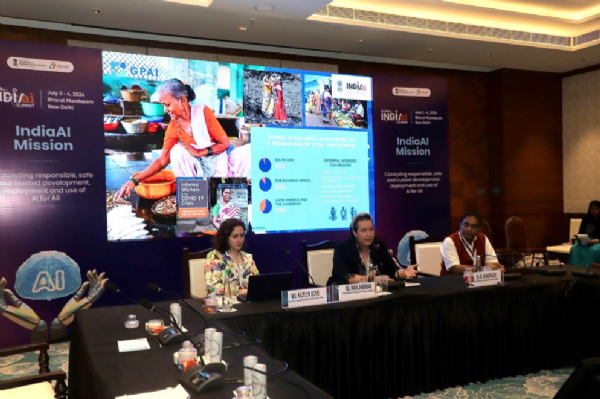#SecurityScan 91: China tracking US warships, Global AI Prioritization & much more
CrowdStrike, a cybersecurity firm, sent out a security update intended to enhance computer safety. Unfortunately, this update contained an error that caused the computers to crash.
Total Views |
This article is a summary of important events that have taken place in last one week affecting, India's national security.
News In Brief
Apple’s India Sales Surge 33% to a Record After Shift From China
Apple wants to challenge Android’s dominance in the country
The increase signals steady progress in Apple’s effort to win users in India, whose consumers are gradually gaining more purchasing power as the economy expands.

Apple Inc.’s annual sales in India hit a record of almost $8 billion, underscoring a rapidly growing market where the iPhone maker now assembles more of its devices and operates two flagship stores.
The India revenue jumped about 33% in the 12 months through March from $6 billion a year earlier.
ASML-Backed University Caught in Middle of US-China Chips War
US ambassador questioned why it has so many Chinese students
A top Dutch technical university that is a key feeder for ASML Holding NV talent has been caught in the crosshairs of the US-China chip war as Washington seeks to limit Beijing’s ability to produce semiconductors.
China Ramps Ups Military Education For Younger Ages To Help Sow ‘Seeds’ Of Patriotism
More primary and secondary schoolchildren are participating in pilot programmes to improve their military awareness and skills.
Chinese team says it can track US warships using free low-resolution satellite images
Team led by Hong Jun of the Dalian Naval Academy says it has tracked US Navy carrier, cruiser and destroyer by analysing images of waves.
A study in ethics: the Chinese science detectives hard on the trail of academic misconduct
The growing industry of ‘scientific sleuthing’ is helping to keep academics ethical amid China’s push for more domestic science publishing. They check copy, paste & plagiarism.
Saudi Arabia replacing the US with China in its security partner mix
Riyadh is building rapport with Beijing and increasing its imports of Chinese weapons amid pressure from Washington over human rights.
US military still has an edge, but China is catching up with hi-tech weapons
Analysts say PLA is narrowing gap with drones and hypersonic missiles, but Washington’s growing alliances could help it maintain advantage.
China Reaches Record Trade Surplus, Raising Alarm Abroad
China’s factories have begun an export blitz, prompting worries around the world about the effect on economies elsewhere.
Trillions in Hidden Debt Drove China’s Growth. Now It Threatens Its Future.
Local governments racked up as much as $11 trillion in off-the-books debt to build industrial districts, resorts, transit systems and housing projects, including many that failed.
China was home for 25 years, but I can’t go back. Here’s why.
Foreigners are frequently detained in the country over a commercial dispute or debt.
Countering Internal & External Security Challenges
TECHNOLOGICAL SECURITY-India AI Mission: Bridging the Digital Divide
The Importance of Compute Capacity
Artificial intelligence (AI) development requires more than just hardware. It involves establishing local data centers, adopting cloud solutions, and building the software necessary to manage AI systems. India, following its Public-Private Partnership (PPP) philosophy, would benefit from a holistic view of compute.
Global AI Prioritization
Vladimir Putin's declaration in 2017 that the nation leading in AI "will be the ruler of the world" put AI on every country's priority list. Since then, global leaders have echoed this sentiment. For instance, China has made AI a national priority, the US under President Joe Biden issued an executive order on AI, the UK hosted a global summit on AI, and AI development and safety have become top agenda items for both the G7 and G20.
India's Early AI Initiatives
India was an early mover in AI with Niti Aayog's publication of the National Strategy for Artificial Intelligence in June 2018. This strategy focused on "AI for All," targeting five priority sectors: healthcare, education, agriculture, smart cities, and smart mobility. In March 2024, the government followed up with the IndiaAI Mission, emphasizing the need to stay ahead in the global race of generative AI and Large Language Models (LLMs).
Funding and Key Pillars
The Cabinet has allocated Rs 10,372 crore (approximately $1.3 billion) towards the IndiaAI Mission. This initiative includes building dataset platforms, innovation and application development centers, and developing future skills. It also focuses on startup financing and ensuring safe and trusted AI. The central pillar, with nearly half the budget (Rs 4,568 crore), aims to build cutting-edge compute capacity to meet local demand and bridge the "AI divide" by providing affordable compute for prioritized sectors.
Evaluating Compute Capacity Goals
The Ministry of Electronics and Information Technology's plan to deploy over 10,000 Graphics Processing Units (GPUs) through strategic public-private collaborations is ambitious. However, this number seems low compared to global standards. For instance, Meta possesses 60 times more GPUs, and even small AI startups globally have more. LLMs and generative AI require massive compute capacity for training and inference; OpenAI used 3,640 petaflops of compute to train GPT-3, whereas 10,000 GPUs translate to just around 25 petaflops.
Governance and Strategic Alternatives
Governance is crucial in managing this initiative. While India has successful national bodies like ISRO and BARC, a central repository of resources managed by bureaucracy has not always been effective. Although the PPP mechanism is mentioned, details are still unclear.
Investing heavily in GPUs may not be the best approach due to the rapid pace of technological advancements. With new models emerging every 12 months and other companies developing AI-specific chips, a strategic alternative could be renting compute from AI cloud providers. This would offer flexibility and potentially more capacity within the same budget. The government should establish strong contractual alliances to ensure sovereign AI capacity is hosted within India's borders.
Holistic Approach to Compute

Compute involves more than just hardware; it includes local data centers, cloud adoption, and software development. As part of the PPP philosophy, India should adopt a comprehensive approach to compute. Both the AI for All strategy and the IndiaAI Mission are commendable steps. The government must now collaborate with industry and geopolitical allies to execute these initiatives effectively and position India as a leader in the AI era.
The Big Computer Problem
Yesterday, something unexpected happened: many computers around the world simultaneously stopped working. Their screens turned blue, a clear sign of malfunction.
Initial Assumptions
Initially, people suspected a major cyber attack. However, it turned out to be a mistake by a company meant to protect these computers.
The Source of the Problem
CrowdStrike, a cybersecurity firm, sent out a security update intended to enhance computer safety. Unfortunately, this update contained an error that caused the computers to crash.
Widespread Impact
This issue was significant because so many daily activities rely on computers. Essential services such as banks and airlines experienced disruptions.
Public Reaction
Many people are upset, believing that CrowdStrike should have tested their update more thoroughly before its release.
Dependence on Technology
This incident highlights our heavy dependence on computers and the internet. When problems arise, they can have global repercussions.
A Silver Lining
Not all computers were affected by this issue. Only Windows-based systems experienced crashes.
Lessons Learned
People are suggesting a need for diversity in the types of computers used for critical functions. Using different systems could prevent widespread disruption if one type encounters problems. It's a reminder not to put all your eggs in one basket.
FOOD SECURITY-India-The world’s next food superpower
Farming in India should be about profits and productivity, not poverty
For years the Araku Valley, deep in the mountains on India’s east coast, was mired in poverty and rocked by Maoist violence. The government classifies most of its inhabitants as “particularly vulnerable tribal groups”; for generations they relied on slash-and-burn farming to scrape by. But now locals grow high-grade coffee that is sold at high prices to posh Europeans. Araku Coffee, the company that processes and markets their berries, runs cafés in fancy bits of Bangalore, Mumbai and Paris. The valley’s transformation is an agricultural success story. It is also a glimpse of what—with the right policies—the rest of rural India might achieve.
SOFT POWER-The Influence of the Indian Diaspora in the US
Excitement over Usha Chilukuri
The Indian diaspora in the United States, particularly those involved in technology and finance, has found new political excitement with Usha Chilukuri. The wife of Trump VP pick JD Vance, Usha's Indian origins have energized the Indian diaspora. The prospect of a "son-in-law" as the US Vice President has engaged this community in the November elections, not just as voters but as campaign contributors, volunteers, and supporters. This development is particularly significant considering the rapid growth of the Indian diaspora, which has become the fastest-growing Indian ethnicity in the US over the past two decades.
Growth in the Tech Sector
The US-based Indian community has grown rapidly, driven by the tech boom, especially around the Y2K era. The number of Indian speakers in the US increased from 320,000 in 2016 to 1.23 million in 2024. Among the Indian diaspora, which is 4.9 million strong and growing, Telgu has become the third most spoken Indian language in America, after Hindi and Gujarati. With their tech orientation, most Indian speakers reside in California, Texas, and New Jersey. By 2017, the community had grown strong enough in California to establish the University of Silicon Andhra, offering courses in Carnatic music and Kuchipudi dance.
Rising Affluence
According to the Indian Mobility Report 2024, Andhra Pradesh and Telangana form the largest cohort of Indian students in the US, making up 12.5% of the total, with the majority pursuing STEM fields. Indians have long been considered the "model minority" but have faced backlash in recent times. This backlash has led Indian associations to advise their members not to flaunt their wealth and to engage locally in politics to ensure their concerns are addressed. With average household earnings exceeding $100,000, Indian-Americans are the highest-earning ethnic group in the US, with 70% holding college degrees, surpassing the American average in both wealth and education.
Political Engagement
Voter turnout among Indian Americans is higher than among other Asian-American groups, with a tendency to vote Democrat. The Chilukuri connection might sway some voters, but Indian-Americans make up only 1.3% of the US population and are scattered across states, limiting the overall impact of their votes. However, the influence of Indian-origin politicians is notably outsized, as seen with Kamala Harris and the two Indian-Americans on the 2024 presidential campaign trail, Ramaswamy and Haley. The affluent and educated Indian political touch is likely to have an impact that extends beyond the election.
#COUNTERING CHINESE MULTI DOMAIN , GREY ZONE, HIGH BREED WARFARE
Advantage India-Philippines wants to point more BrahMos missiles at China

Manila seeks additional India-made supersonic anti-ship missiles amid escalating sea tensions with China and doubts about US mutual defense backing. After a series of major maritime standoffs, the Philippines is in hot pursuit of more India-made BrahMos supersonic cruise missiles to point at China in the contested South China Sea.
The Philippine Marine Corps (PMC) plans to bolster its coastal defenses with two additional batteries of the shore-based supersonic anti-ship missile by 2026.
Xi Jinping Continues Business Power Grab Despite Economic Setbacks
Setting Economic Priorities Amid Slowing Growth
Chinese President Xi Jinping will set his economic priorities and reinforce his control at a Communist Party meeting this week, amid slowing growth and struggling consumers. Xi plans to appeal to private businesses to support his personal vision for China’s future as he outlines a much-heralded economic reform program.
Meeting with Business Leaders
In the lead-up to this important meeting, Xi has been engaging with business leaders, addressing the growing unease among foreign companies about the tightening restraints on their operational freedom. Despite these concerns, Xi shows no sign of altering his approach to powerful tycoons, whom he views as threats to party orthodoxy.
Stance on Over-Indebted Companies
Additionally, Xi remains steadfast in his refusal to allow over-indebted companies to collapse, indicating his commitment to maintaining strict control over China's economic landscape
How China Could Hobble the Internet: The Threat to Undersea Cables
Growing Concerns Over Undersea Infrastructure
Not long ago, a part of the British government asked RAND Europe, a think tank in Cambridge, England, to research undersea critical infrastructure. The think tank studied publicly available maps of internet and electricity cables, interviewed experts, and held focus groups. Halfway through the project, Ruth Harris, the leader, realized they had inadvertently unearthed many sensitive details that could be exploited by Russia or other adversaries.
Discovery of Sensitive Information
When Harris approached the unnamed government department with this discovery, they were shocked. "Oh my god. This is secret," was their reaction. Upon learning that Harris's team was drawn from all over Europe, the department demanded that the project be overhauled to include only UK personnel, saying: "This needs to be UK eyes only."
Undersea Cables as Military Targets
Western governments have quietly been concerned about the security of undersea cables, which carry most of the world’s internet traffic, for many years. However, this issue has recently come into sharp focus due to a series of murky incidents from the Baltic Sea to the Red Sea and a broader realization that infrastructure, of all sorts, is a target for subversion and sabotage.
Previously, a part of the British government asked RAND Europe, a think tank in Cambridge, England, to research undersea critical infrastructure. The think tank studied publicly available maps of internet and electricity cables, interviewed experts, and held focus groups. Halfway through the project, Ruth Harris, the leader, realized they had inadvertently unearthed many sensitive details that could be exploited by Russia or other adversaries.
Discovery of Sensitive Information
When Harris approached the unnamed government department with this discovery, they were shocked. "Oh my god. This is secret," was their reaction. Upon learning that Harris's team was drawn from all over Europe, the department demanded that the project be overhauled to include only UK personnel, saying: "This needs to be UK eyes only."
Undersea Cables as Military Targets

Western governments have quietly been concerned about the security of undersea cables, which carry most of the world’s internet traffic, for many years. However, this issue has recently come into sharp focus due to a series of murky incidents from the Baltic Sea to the Red Sea and a broader realization that infrastructure, of all sorts, is a target for subversion and sabotage.
World At War: Lessons For India
CHINESE VIEW-The US Needs Policies to Avoid Conflict with China
China's Determination and Recent Escalations
China has demonstrated a willingness to use force to defend its claims, as seen in recent escalations with the Philippines and along the Sino-Indian border. Beijing's actions are tied to the political legitimacy of the Chinese Communist Party and the "China Dream" of national rejuvenation by 2049. These territorial claims have been a goal since the late 1800s and are viewed as vital to national survival.
Flaws in Current US Policies
Given China's strong interest in its territorial disputes, the US reliance on accident avoidance or threats of force is irresponsible. Washington's promises to defend the Philippines and Japan over their disputes with China already lack credibility. Smarter policy options are needed to avoid a conflict that could weaken – or even destroy – America.
Strategic Approaches for Taiwan
For Taiwan, the US can meet its legal obligations while remaining below the threshold of conflict by revising the Six Assurances and tying arms sales to Taiwan's willingness to defend itself. Diplomatic efforts should be prioritized to resolve the issue.
Managing East and South China Sea Disputes
Regarding the East and South China Sea disputes, the US should minimize potential American deaths over rocks and reefs by clarifying mutual defense treaties and encouraging Manila and Tokyo to manage their disputes with Beijing creatively. The US can support a mutually-agreed South China Sea Code of Conduct to lower regional tensions.
Avoiding Involvement in the China-India Border Dispute
On the China-India border dispute, the US should avoid involvement, as it has no interest and much to lose. Smart policies are crucial to protecting America's national interests and ensuring its strength and survival.
--



